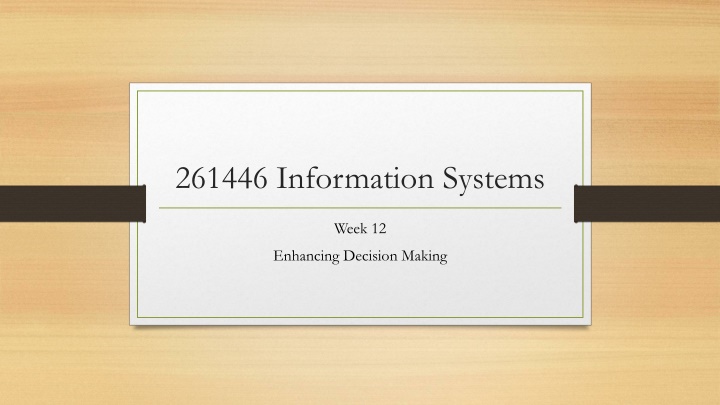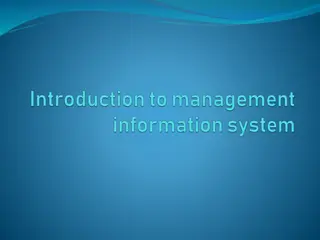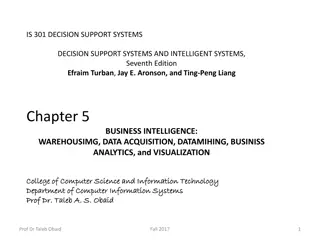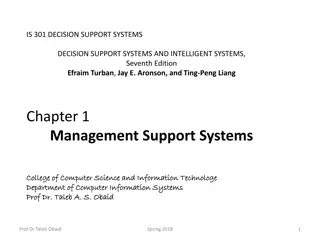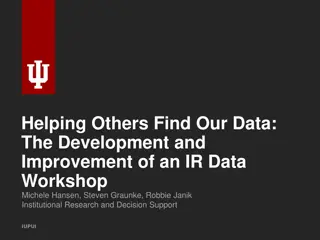Enhancing Decision Making with Information Systems
Explore the role of information systems in enhancing decision-making processes within organizations. Topics include business intelligence, types of decisions, decision-making processes, and managerial roles. Learn about structured, unstructured, and semi-structured decisions, different models of managerial roles, and factors affecting decision quality. Discover how information systems can impact decision-making outcomes and the importance of having accurate information for making informed decisions.
Uploaded on Oct 03, 2024 | 3 Views
Download Presentation

Please find below an Image/Link to download the presentation.
The content on the website is provided AS IS for your information and personal use only. It may not be sold, licensed, or shared on other websites without obtaining consent from the author.If you encounter any issues during the download, it is possible that the publisher has removed the file from their server.
You are allowed to download the files provided on this website for personal or commercial use, subject to the condition that they are used lawfully. All files are the property of their respective owners.
The content on the website is provided AS IS for your information and personal use only. It may not be sold, licensed, or shared on other websites without obtaining consent from the author.
E N D
Presentation Transcript
261446 Information Systems Week 12 Enhancing Decision Making
Week 12 Topics Decision Making and Information Systems Business Intelligence in the Enterprise Business Intelligence Constituencies
Case Studies Case Study #1) Big Data & IoT Case Study #2) Is Predix GE s future?
Making Decisions How much value is there for businesses making the right decisions?
Types of Decision Structured Decisions Repetitive & routine following a definite procedure. Unstructured Decisions Require judgment, evaluation and insight to solve a problem. Each decision is new and important, with no understood procedure for making the decision Semistructured Decisions Part of the problem follows a defined procedure
Decision Making Process
Managerial Roles Classical Model of Managers (Fayol 1920-1990) Managers have 5 functions Planning Organising Coordinating Deciding Controlling
Managerial Roles Behavioural Model of Management 5 Attributes Managers do a lot of work, at a fast pace Activities are fragmented many short duration activities Managers prefer current, specific, ad hoc information Managers prefer oral communication Managers maintain a diverse / complex network of contacts as an informal information system
Managerial Roles Mintzberg (10 Roles in 3 Categories) Informational Monitor, Disseminator, Spokesperson Interpersonal Figurehead, Leader, Liaison Decisional Entrepreneur, Disturbance Handler, Resource Allocator, Negotiator
Wrong Decisions? IT doesn t always provide the information to make the right decision Information Quality Management Filters Organisational Inertia & Politics
Wrong Decisions? Information Quality Accuracy Integrity Consistency Completeness Validity Timeliness Accessibility
Wrong Decisions? Management Filters Even with all the right information, managers can still make the wrong decision. Humans interpret information through filters as we understand the world around us Selective Attention Focus on certain problems Focus on certain solutions A variety of biases to reject information that doesn t conform to prior conception
Wrong Decisions? Organisational Inertia & Politics
Business Intelligence One definition of human intelligence refers to our ability to take data from our environment, understand its meaning & significance, and act appropriately How about Businesses? Businesses are human environments, so why not Business Intelligence?
Business Intelligence Environment Data from Business Environment Structured & Unstructured data, from many sources, including Big Data Business Intelligence Infrastructure Powerful database that captures all relevant data; relational or data warehouse / datamarts Business Analytics Toolset Software tools to analyse data, track performance & answer ad hoc manager questions
Business Intelligence Environment Managerial Users & Methods BI is only as intelligent as the humans using it - managers have to ask the right questions or track the right bits of data Delivery Platform MIS, DSS, ERP Layer responsible for delivering information to different people at different levels in the firm, from operational level, through middle managers to senior executives User Interface Not just a spreadsheet! Visualisations available on multiple different devices
BI & Analytics Capabilities Production Reports Predefined reports Parameterised Reports User enters several parameters (e.g. region, time of day, different product sales), to produce a report, like a pivot table Dashboards / Scorecards Visualisations representing specified performance data Drill down The ability to move from high-level summaries to detailed view Forecasts, Scenarios, Models Linear forecasting, what-if scenarios & other statistical analysis
Gaining BI Capabilities Hardware Firms (IBM, HP, Oracle (Sun Microsystems)) Want to sell a totally integrated solution the complete deal with an integrated hardware/software solution, built to only run on their hardware Software Firms (SAP, SAS, Microsoft) Encourage organisations to pick the best of each part the best database, the best data warehouse, the best intelligence & analytics, from whichever vendor is best What do you think?
Risk & Reward Totally Integrated Solution Dependent on one firm & it s pricing power Only need to deal with one vendor Best of Breed Greater Flexibility & Independence Potential compatibility difficulties in integrating software and hardware platforms
